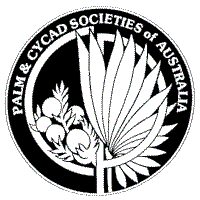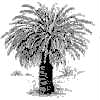|
Palms
Cocos nucifera in Australia |

| |||
|
| ||||
Common Names:
"Kunga" - Lockhart River
"Warraber" or "Warraper" - Torres Strait
"Coconut Palm" - north Queensland generally.
Distribution:
Occuring spontaneously from about Ingham and
the Palm Islands, north to Torres Strait and south into the
eastern Gulf of Carpentaria. A commonly cultivated plant, now
pantropical in distribution.
Habitat:
On sand and coral debris beaches, often those
subjected to erosion, on mainland, continental island and
coral cay shores. Also occasional in brackish mangroves and
along the landward fringe of mangroves along the coast and in
larger river estuaries.
Description:
The coconut is so familiar to humanity, particularly
in the tropics, that it is perhaps a waste of space to
include a description here. There is also such a great
variety of growth forms, fruit shapes and sizes and plant
coloration that a really meaningful description would have to
be very lengthy.

Figure 1. Chilli Beach, Iron Range
Notes:
The coconut has been the subject of much interpretation
and speculation in regard to its natural origin. Because it
is widely cultivated and has been subjected to much selection
over most of its range, it is now impossible to say with
any certainty that it originated in any particular place.
Current thought indicates an origin in a wide oceanic arc
extending from the western Indian Ocean, eastwards into the
central Pacific. Within this region are the myriad islands of
the Indonesian Archipelago, Sumatra, Java, the Malay
Peninsula, Borneo, Sulawesi, Papua New Guinea, Cape York
Peninsula and the many western Pacific Island groupings.
Some authors point to an origin in South America, where the closest relatives of the coconut occur, however, this is not supported by any important ethnobotanic evidence. Ethnobotany is concerned with man's understanding and technologies relating to plants, and certainly the deep cultural entrenchment of coconut utilisation and husbandry in the oceanic arc mentioned above, far surpasses the crude understanding shown the coconut in the New World.
Another issue which often evokes lively debate is whether the coconut existed in Australia before the Europeans arrived. Certainly the coconut was cultivated in Torres Strait long before the Europeans decided to take their colonial ways to new lands, but early explorers often noted the apparent absence of these palms from the north Australian shores. Information gathered in those early days of Australian exploration are frequently characterised by very narrow attitudes and the Aborigines were usually passed off as unsophisticated due to their lack of cultivation.
Certainly the small Aboriginal population had little need to settle and cultivate the soil, but their knowledge of the properties and uses of the vegetation remains to be surpassed by our modern society. They had names for most plants, recognised plant habitats and could anticipate oncoming crops. The Aboriginals on the northern Peninsula were no different in this way and understood much about the very complex vegetation there. At Lockhart River, the only eastern Australian Aboriginal Community to have retained much of their traditional culture, the coconut is known to them by their own dialectual name and features in certain traditional ceremonial and culinary arts.
Old people have amusing stories to tell about the inter-clan rivalties in which the coconut trees belonging to one clan (because they grew on their land) were frequently cut down by rivals as an act of attrition. The people apparently never planted the seeds, and would often destroy a germinating nut in order to obtain the "pitjiri' or soft and edible haustorial growth inside the cavity. The only trees that grew there were those that drifted up naturally and survived long enough to establish. Coconut husks also feature in certain ceremonial artefacts which are probably of ancient design. Unfortunately, the Lockhart River culture dwindles each year as more of the older people die and fewer of the younger people assume the great responsibility of learning the stories, songs and dances.
Today, there are numerous occurances of coconuts growing on the peninsula coasts, some definitely planted, as in the coconut plantations as Somerset, Mappoon and Batavia River (now the Wenlock River). Others are not so easily explained, and such locations are interesting for a number of reasons.
Firstly, they are often in places which for reasons only an oceanographer would understand, attract considerable amounts of exotic flotsam. It is not uncommon to find entire Sago palm ( Metroxylon sagu ) trunks washed up. The Aboriginals actually knew how to extract the starch from these trunks which are not produced in Australia but come from Papua New Guinea. Other items of interest are dug-out canoes, treefern, bamboo and pandan stems, pandan fruits and various wooden items of obvious Polynesian origin. Barnacle-encrusted coconuts, some able to germinate are also frequent. It is quite reasonable to assume that living coconuts have been a regular part of the flotsam on these beaches for centuries.
Secondly, the variety of coconut forms represented in these groves indicate that there are a multitude of regional origins. Most of the dwarf cultivars are present and a few very unusual tall forms are occasional. Near Iron Range there is a number of trees which have the leaves undivided, like the so called "Weeping Coconut" of Fiji. No doubt these plants originated from seeds drifted in from distant cultivations, but the assumption that a number of origins is involved is reasonable in the light of the fact that in most areas only one or two selected varieties are grown in any number. Many of the forms occuring on the Peninsula coasts have fruits containing very small seeds, some almost spindle-shaped. Such forms would rarely be deliberately cultivated amongst societies dependant on the fruits as food, and may represent forms close to a "wild" coconut.
Whatever the truth about the naturalness and origins of the coconuts on the Peninsula, they remain interesting and often very useful to travellets and should not be excluded from a treatment of the regions palm flora.
Extracted from: Palms of Subequatorial Queensland by Robert Tucker
| For further information try | |||||||||||||||||||||||||||||
 |
 |
|
VPE |
PALM Web |

| ||||||||||||||||||||||||
 |
 |
 |
 |
 |
 |
||||